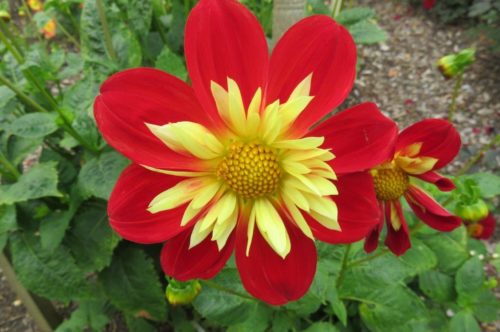
Dianthus was once made into a 14th century plague treatment… perhaps we should try it, muses gardening writer CEDRIC BRYANT.
DAHLIAS grow extremely well in Canberra, and now is planting time.
Introduced to Europe in the 16th century, following the Spaniards’ invasion of central America, dahlias were grown by the Aztecs for food and medicinal purposes, such as treating epilepsy.

Dahlias are related to sunflowers, both native to the same area, and recorded as grown from 1000BC for their seed and oil. The dahlia has been the national flower of Mexico since 1963.
When considering how a flower comes to look the way it does, factors such as botany, geography, history and even fashions come into play.
Dahlias are hugely popular in Holland for the cut-flower trade. There are more than 20,000 cultivars now registered with the International Register of Dahlia cultivars, founded in England back in 1881.
The book “A Guide To Growing Dahlias” by the Dahlia Society of NSW and the ACT, says it’s important to plant in a friable, free-draining soil, preferably a raised bed. Put the support stake in first, about 60cm apart for smaller varieties and up to one metre for taller varieties, as these can grow to 1.8 metres high. Plant the tuber close to, but not right up against, the stake. Make a bank around the tuber to stop water run-off and allow fertiliser to go directly to the tuber.
Once the plants are well established, mulch to conserve moisture to about 75mm thick. Tie up the stalks as the plant grows, as it can become top heavy with the abundance of flowers. I prefer the green Velcro reusable tape rather than string, which can cut into the stem.
Insect pests can be a problem, in particular earwigs. Most dahlia growers use organic methods to control these pests, placing an empty cardboard milk carton upside down on top of the stake. The earwigs enter overnight and each morning, just empty them into a bucket of hot water.
Mushroom compost should not be used near acid-loving plants such as rhodos, azaleas and native plants due to its lime content, advises the Australian Mushroom Growers’ Association.

COMING into flower now is dianthus, known as pinks and the forerunner of carnations. They were first mentioned by the Greek philosopher and botanist Theophrastus in about 370 BCE, and also got a mention in Shakespeare’s “Romeo and Juliet”. The name “pink” appeared first in the 14th century, and came from the frilled edge of the petals, where “pink” meant “to decorate with a perforated or punched pattern”, like pinking shears in dressmaking. At that time, the petals were made into a conserve combined with sugar to combat the plague. Maybe we should try it?
Dianthus’ popularity soared in 18th century formal gardens, especially by the French and English. Today there are hundreds of cultivars, with more than 100 given the prestigious “Award of Garden Merit” by the Royal Horticultural Society. Buy them now, when in flower, and plant in groups.
Who can be trusted?
In a world of spin and confusion, there’s never been a more important time to support independent journalism in Canberra.
If you trust our work online and want to enforce the power of independent voices, I invite you to make a small contribution.
Every dollar of support is invested back into our journalism to help keep citynews.com.au strong and free.
Thank you,
Ian Meikle, editor




Leave a Reply